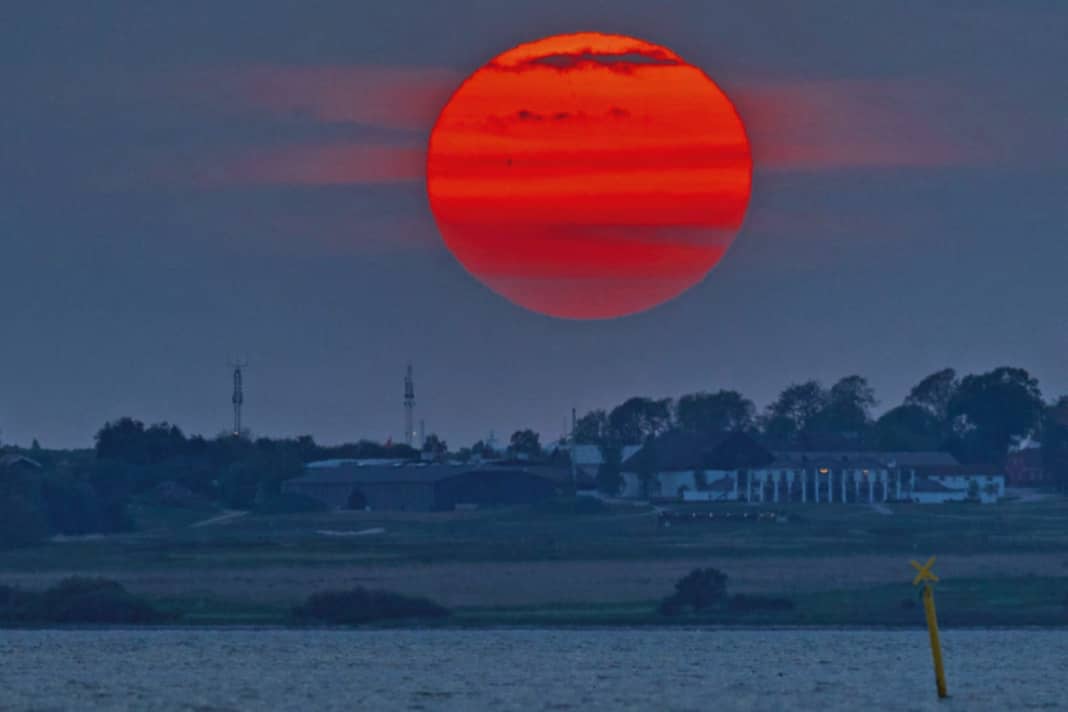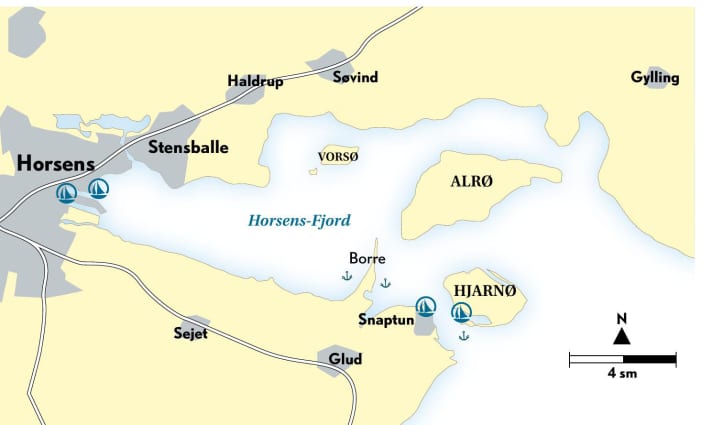





The fjords between Fredericia and Aalborg are not large sailing areas. But they surprise with unexpected diversity. Each one offers pretty harbours, perfect anchor bays and great land attractions - enough for a whole holiday. Let us introduce you:
- Vejle Fjord
- Horsens Fjord
- Mariager Fjord
It is just under ten nautical miles from Hjarnø Sound westwards inland to Horsens. The offshore islands of Hjarnø and Alrø and the Borre headland to the south form a natural barrier that is constantly changing due to currents and wind. Protected from the eyes of enemies and the rages of Njörd, the Norse god of the sea and the wind, Vikings found shelter here as early as the 12th century and founded a flourishing trading centre.
The village of Snaptun south of the entrance to the fjord is known to many sailors as a stopover on a trip in the Kattegat. This is exactly where our fjord adventure begins. The ferry departs from the small harbour for fishing and sports boats and takes residents and holidaymakers across the three-cable-long Hjarnø Sound: "Hjarnø is a special place, always has been," says Jesper, the ferryman. Holidaymakers appreciate the beaches, the large lagoon and the quaint café at the harbour. And like everywhere else in the fjord area, there are traces of the Vikings. There are ten ship foundations on the island, "Kalvestenene", which were used as grave markers.

Horsens Fjord: in the footsteps of Vikings and fish
There is little space for yachts in Hjarnø Bro island harbour. However, day visitors are allowed to moor at the outer pier. To the south-east of the harbour there is good anchorage with a view of the old church and the Odden sandbank.
Sailing further to the west and around the Borre peninsula, you really get into the fjord. If it smells of fish, the course is right. Large aquacultures are installed in the sound. On the shores, Jutlandic cultural landscape: reed banks with lots of shallow water, small beaches, gentle hills, sometimes wooded, sometimes farmed.
There are good anchoring opportunities on the west and east sides of the Borre peninsula. There are also Dansk Sejlunion mooring buoys. The shallow waters on the shore to the west are also mostly sheltered from the wind and are ideal for wonderfully calm nights. The last few miles to Horsens lead to several harbours that bear witness to the town's maritime history. "Yachts are best moored in the eastern New Harbour, which unfortunately isn't so new anymore," smiles Mikkel, pointing to a few dilapidated parts of the jetty. "But it's a good place and everything is available for yachties." Mikkel keeps his 44-foot yacht here all year round. "For me, the area on the doorstep is the ideal place to chill out at anchor. Then I sail in the Kattegat, it's too crowded here for that." There are also moorings in Gamle Havn, but the facilities are a lot more rustic.
In Horsens, the fish processing and freight areas are being converted into office and residential neighbourhoods. They blend in or stand out from the existing buildings of the venerable trading town. Incidentally, the city has a famous son: naturalist and captain Vitus Bering. He sailed the west coast of Alaska and the east coast of Siberia in 1741. In between: the Bering Sea.
Horsens Fjord: Tips for shore leave
- On the last weekend in August there is a medieval festival at the fjord. ( discoverdenmark.dk )
- The city's art and regional history museums are well worth a visit. ( museumhorsens.dk )
- The "Fængslet", the former city prison, is now a museum and venue for concerts, art and cultural festivals. ( faengslet.dk )
- Take a walk in Boller Slot, the park by the castle pond.
Further information about the area
The Vejle Fjord is easy to sail. However, the water levels can fluctuate considerably depending on the wind. The harbour fee for nine-metre yachts is usually 130 to 180 Danish kroner (equivalent to 18 to 24 euros). Payment is usually made at a machine or online. The town of Horsens at the end of the fjord is ideal for a crew change. It is easily accessible by train via Hamburg-Flensburg-Kolding or via the E45 motorway.
Recommended reading for a trip to the fjords
- Jan Werner: "Cruising Guide Denmark 1, Jutland - Anholt - Læsø" (31,99 Euro)
- Peter Hotvedt: "Harbour guide, Denmark and southwest Sweden" (69,90 Euro)
- Set consisting of the Delius Klasing sports boat chart sets 1, 4 and 5: "Danish Baltic Sea + Bay of Kiel" (199,90 Euro)
Fjord or fjord? The origin makes the difference
In Scandinavia, the term fjord refers to an arm of the sea that extends deep inland. From a geological point of view, however, there are differences in how they were formed, and the process of formation also explains the different characteristics of the landscape. According to geological interpretation, fjords were formed by the process of glacial erosion during the ice ages. The ice masses carved deep furrows in the rock massifs, and as they melted they left behind outflows towards the sea. The Norwegian fjords are exemplary for this. In the case of a fjord, a different geological process was at work: as a result of the coastal formation being altered by the advancing ice masses and the rise in sea level after the last ice age, the sea was able to penetrate the flat areas. Storms and tides put the finishing touches to the landscape. This was the case on the Jutland mainland. The landscape and water depth of the fjords were also characterised by factors such as rock type, vegetation and erosion. This also explains the different characters of the fjords of Vejle Horsens and Mariager explain.

